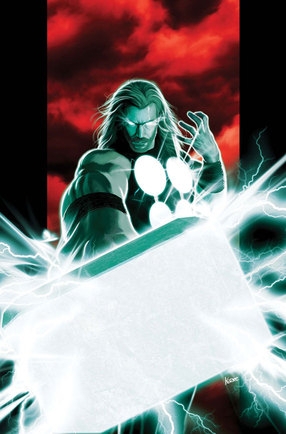Ultimate Comics: Ultimates #2
By Zak Edwards
September 28, 2011 - 21:44
Marvel Comics
Writer(s): Jonathan Hickman
Penciller(s): Esad Ribic
Colourist(s): Dean White
Letterer(s): Clayton Cowles
Cover Artist(s): Kaare Andrews
$3.99 US
Jonathan Hickman’s two titles in Marvel’s Ultimate universe can be summed up as follows: Nick Fury has a lot of stuff to do. A lot. S.H.I.E.L.D’s continual expansion, while indicative of the world around us and the rapid shrinking of the world through globalization, is offering some really cool potential stories and hopefully Hickman can continue to explore them for a while to come. Marvel’s recent reinvestment into their Ultimate line has been overwhelmingly good quality, to the point where the critical mainstay, Ultimate Spider-Man, is the book I am now least interested in. The excitement and energy, combined with the bottle universe where things can happen simply because it's young enough to do it, has returned with a quiet fervor. Ultimate Comics: Ultimates is no exception and is crafting a story that is both large concept and feels like it actually matters.
 |
Esad Ribic's art is, and this is probably the best way to put it, really pretty. Every panel looks like a labour in itself, a moment to be considered. Unfortunately, with such still art, the book doesn’t move very well. Additionally, Ribic has a strange way of depicting eyes, which seems to be as much the fault of Dean White, who makes most characters look like they’re experiencing a serious hangover (and for Tony Stark this may be true), as Ribic. Other than these two minor details, Ribic’s art is captivating. The characters are all brought to life on the page, with characteristics, like Captain Britain’s smugness, are conveyed visually rather than relying on dialogue, and Thor’s seriousness is disconcerting. Almost silent the entire issue, abandoning his usual position as team conscience, the threat of the Children of Tomorrow require only the grave looks of Thor. It sounds strange, but Ribic clearly conveys what Thor is thinking through a series of small panels showing only his face. Beautiful and engaging, Ribic’s art is a far cry from the grittier photorealism of Bryan Hitch, but this is in no way a bad thing.
Grade: A Demands a few readings, Hickman’s Ultimates is beautiful and intelligent.
Related Articles:
The ultimate G.I. Joe Classified Army-Building Guide Part Three
The ultimate G.I. Joe Classified Army-Building Guide Part Two
The ultimate G.I. Joe Classified Army-Building Guide Part One
Review: Ultimate Chicken Horse
Bluefin Announces Ultimate Muhammad Ali Action Figure
Review: Gears of War Ultimate Edition
Ultimate Comics: Spider-Man #23 Review
Ultimate Comics: Spider-Man #16.1 Review
Ultimate Comics: Spider-Man #16
Ultimate Comics: Iron Man #1
